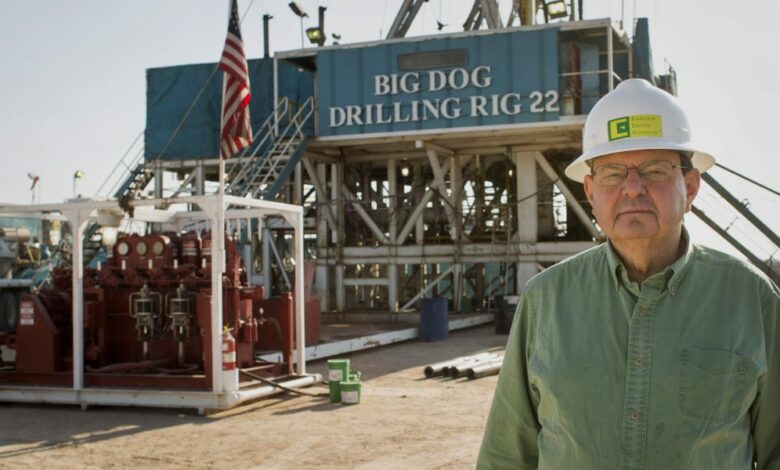Big Shale means ‘consolidate or get eaten.’ Wall Street is all in


This week’s $26 billion combination of two Texas oil companies is the latest in a series of deals that’s ushering in the era of Big Shale. Wall Street, which eyed the sector with skepticism for most of the last decade, appears to be all in.
Diamondback Energy Inc.’s takeover of Endeavor Energy Resources LP announced on Feb. 12 topped off a year of roughly $250 billion in US oil and natural gas deals that consolidated a fractured collection of private wildcatters into larger corporations.
Diamondback boldly touted itself as “the must-own” stock in America’s richest oil field, and in a stark reversal of the knee-jerk punishment typically meted out to suitors in corporate acquisitions, the stock jumped 11% in a matter of hours. It was perhaps the surest sign of investor approval.
By the end of the week, the shale explorer touched a record high and swelled its market valuation by $5 billion, even though the transaction won’t close for several months.
On a broader scale, the consolidation wave is healing the hangover from years of overspending by shale drillers who pursued output growth at the expense of investor returns. While it was small upstarts who pioneered the shale revolution, Wall Street demands for scale, efficiency and cash returns mean the new era is turning into one of survival of the biggest.
“It has become a big-company game,” said Mark Viviano, a managing partner at Kimmeridge Energy Management Co., which has been hammering the shale-sector to consolidate for half a decade. “Now you have an arms race for operational scale and investor relevancy.”
The evolution of the shale industry comes at a time when energy makes up just 3.8% of the S&P 500 Index despite America’s status as the world’s premier oil producer, pumping 45% more crude than Saudi Arabia. To put the transition in perspective, the cohort of publicly traded shale explorers shrank by about 40% over the past six years to roughly 50 today, according to Warwick Investment Group LLC.
“It’s kind of like Pac-Man right now: consolidate or get eaten,” said Kate Richard, chief executive officer at Warwick, which has invested in thousands of shale wells. “We’re probably going back to the ‘70s, where there were seven to 10 major players in the US.”
Once the Endeavor deal is complete, Diamondback will double its market value to around $60 billion, making it a contender with EOG Resources Inc. for the title of biggest pure-play shale stock.
“It put us in a new weight class, which is a good thing in this business,” Kaes Van’t Hof, Diamondback’s 37-year-old chief financial officer, said during an interview. “The perception is that bigger means more durability” through oil’s boom-and-bust cycles, as well as lower capital costs and a deeper portfolio of drilling prospects.
In the wake of the deal announcement, Diamondback is trading at 9.9 times earnings, overtaking EOG, which has pledged to sit out the current buying spree. Diamondback will jump to around 150th in the S&P 500 by market value, from 275th today, putting it on the radar of large investors in search of more exposure to the Permian Basin, the prolific oil field straddling the Texas-New Mexico border.
For Diamondback, a bigger balance sheet means easier access to capital and more ability to sustain payouts to investors through oil price shocks. In addition, a broader geographic footprint in the Permian region means more potential drilling sites to choose from an prioritize. It also means more clout negotiating terms with the service companies that provide everything from rigs to drill bits to fracking crews and pipes.
“Big buyers are likely to spearhead a fresh wave of efficiency gains driven by technological advancements in both production and cost management,” said Teresa Thomas, US energy leader at Deloitte LLP.
One phenomenon that often flies under the radar is that takeovers of this sort tend to presage a slowdown in oil-production growth. A spate of follow-on deals could help support global crude prices and take some of the pressure off the OPEC+ alliance that has been restraining output in a bid to buoy the market.
Endeavor was one of the Permian’s fastest-growing operators, increasing production 30% since 2022. But after merging with Diamondback, that growth will slow to less than 2%, with the cash that would have gone to leasing drilling rigs and related costs freed up for dividends and buybacks.
The new era also represents a changing of the executive guard. Autry Stephens, Endeavor’s octogenarian founder, will become America’s richest oilman once the deal closes. His exit leaves a lasting legacy.
“He’s one of the last original wildcatters, funding things out of your own back pocket and taking risk,” said Sam Sledge, CEO of Midland, Texas-based ProPetro Holding Corp. “We’re playing a different game now.”
Source link




